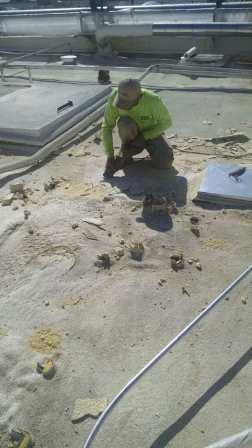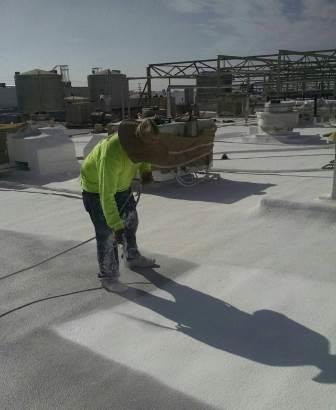Syrups, jellies, juices. Oh my! The spray polyurethane foam (SPF) roof at a food service company that develops and markets various foods in California needed to be replaced. Sergio Madrigal, president of coating and foam contractor E&C Insulation (ECI), found a variety of issues on the roof when he arrived on site and suspected some earlier installation issues. “We came into a roof that was in very bad shape. The original applicator was basically just applying the foam to the surface and not with the intent of allowing the roof to drain properly,” he said. “And so my crew came in and we corrected all of the ponding issues, repaired all of the delaminated foam, and pretty much renewed the roofing system to our standards.”
That would mean the crew of up to seven members needed to fix blisters and ponding areas, apply spray foam and coatings, and work around the ever-changing weather. Their successful completion after six weeks of hard work was sure to be sweet!
Get Lifted
“The roof was a pretty good size,” Madrigal said — 60,000 square feet (5,574.2 m²) to be exact. Because there were parapet walls around all of the exterior edges of the roof, which the crew approached in four sections, the crew didn’t need to worry about wearing fall protection. But they did have to focus on the prep — lots of prep!
To start, the crew pressure washed the spray foam roof. They immediately covered the exposed foam with General Coatings Recoat Primer using a Graco 30-1 Pneumatic sprayer. Then, they protected any heating, ventilation, and air conditioning (HVAC) units in the immediate area with a mesh tarp (they’d remove those after applying the spray foam as they went along).
The crew cut out any blisters using Milwaukee Tool Sawzalls, ground down “humps and bumps,” as Madrigal called the ponding areas, with foam scarifiers by J. Calman Industries, and inspected the open SPF areas for adhesion and saturation. “If the spray foam was adhered and dry around the perimeter, then we’d stop there,” he said. “If it was still delaminated, then we’d keep removing the spray foam until we found spray foam that was adhered to the substrate. If we found moisture, regardless if it was adhered, we kept cutting until we got to dry foam.” The crew used new spray foam to patch any exposed areas.
Let the Sun Shine
The challenges on this project were not few and far between.
Gaining access was straight forward; the crew relied on traveling through the inside of the building or using ladders outside. But once up top, maneuvering around the heating, ventilation, and air conditioning (HVAC) units was tricky. “There were a lot of units; it was a very, super-congested roof,” Madrigal explained.
 The more pressing issue on this project, though, was the weather.
The more pressing issue on this project, though, was the weather.
“When you’re working on a roof like this, you’re constantly checking the forecast,” Madrigal said. “If we’d see rain coming in the very next day, then we’d quickly need to look at all of the open areas of the roof — the areas that were cut out — so we could make everything watertight before we left that day.” There were material and labor requirements to accommodate the rain, and it also took a lot of time for the crew to cover their bases.
“We were going back and forth; we couldn’t really be productive when there was weather coming in because sometimes we were pulling emergency applications just to stay water tight,” explained Madrigal. When the rain stopped, two to three members of the crew would have to come back to blow water off any areas, cut out the emergency patches, and respray those areas.
On top of the patches and old spray foam, the crew laid down an even layer of SPF at approximately 1 inch (2.5 cm). The crew wore 3M respirators, goggles, and gloves during the prep and spray foam stage. The foam was a 2.7-pound (1.2 kg) closed-cell version from General Coatings called Ultra-Thane. The crew applied it in one 1-inch (2.5 cm) pass using two spray rigs from Graco, H-20-35 and H-40, and 310 feet (94.5 m) of hose for each.
“All the spray was performed on weekends when most of the personnel were not present, so we were able to mark off the parking lot for the very minimal personnel working on the weekends,” Madrigal explained. Because the prep could be completed with people on the ground below, the crew completed that step during the week. On top of the foam, the crew applied approximately 32 mils (812.8 microns) of Ultra-Flex 1000, an acrylic elastomeric, with a Graco 45-1 Extreme Pneumatic. Into the topcoat, which was installed immediately so as not to expose the foam, the crew blew in white roofing granules using a five-bag Clemco sandblasting pot. They used the equipment at very low pressure to achieve an even distribution of the granules to rejection.
 Applying the elastomeric also depended on the weather. The crew needed to have at least four hours for the sprayed coating to “skin over” so that if rain fell on it, it would just “float” on the rooftop and not wash the newly installed layer away. “It had to have enough time to dry before the next day’s rain,” Madrigal said. “The weather was key. It was a big part.”
Applying the elastomeric also depended on the weather. The crew needed to have at least four hours for the sprayed coating to “skin over” so that if rain fell on it, it would just “float” on the rooftop and not wash the newly installed layer away. “It had to have enough time to dry before the next day’s rain,” Madrigal said. “The weather was key. It was a big part.”
Get Down Tonight
“As far as the crew, I think they did an outstanding job fulfilling and exceeding the customer’s expectations,” Madrigal said. He continued, “The client was very pleased with that and they just awarded another project that we just finished.”
For Madrigal, it was a “very challenging job,” and he is happy that the crew was “able to pull it off.” Descending the roof for the last time, the crew left behind them one thing that won’t be pulling off any time soon: the new SPF roof!